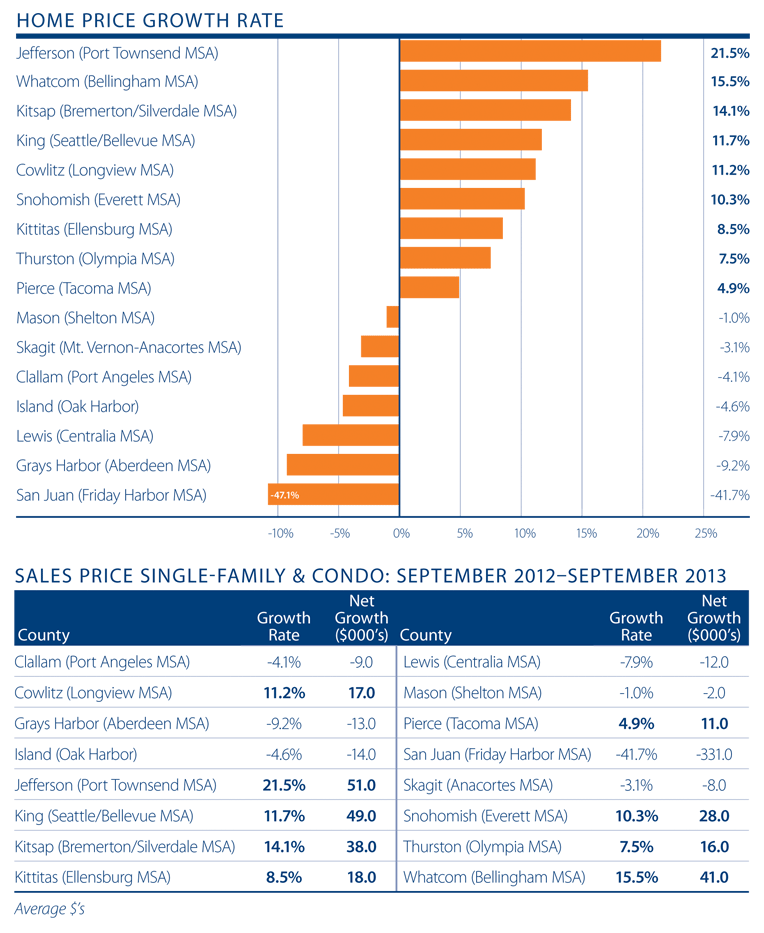Windermere Real Estate is proud to partner with Gardner Economics on this analysis of the Western Washington real estate market. This report is designed to offer insight into the realities of the housing market. Numbers alone do not always give an accurate picture of local economic conditions; therefore our goal is to provide an explanation of what the statistics mean and how they impact the Western Washington housing economy. We hope that this information may assist you with making an informed real estate decision. For further information about the real estate market in your area, please contact your Windermere agent.
Regional Economics
This report is a little late as, along with many others, we were at the mercy of the Federal government shutdown in early October. This shutdown did not just delay our employment data, it was also decided that September figures were not important and, therefore, there was no count at all!
As such, we were forced to use August’s figures which, while certainly not perfect, at least provide us with some indications as to the direction of our regional economy.
Looking at total employment, the numbers continue to impress with the overall area adding 53,960 new jobs over the past 12 months—up from the 50,670 seen between July 2012 and July 2013.
Total employment growth over the past year was seen in all but eight counties. I have to say that it continues to frustrate me that we still have several counties where employment gains remain hard to find. Although the job losses were very limited—other than in Cowlitz County—I will still rest easier when I see these secondary markets improving their employment bases.
Unsurprisingly, King County (+3.8%) maintains its top position relative to employment growth. This was, somewhat surprisingly, followed by Whatcom County (+3%). Mason (+2.4%), Kittitas (+2.4%), and Pierce (+2%) rounded out the other top-performing counties.
As I mentioned earlier, job losses were generally modest, with San Juan (-3.3%), Cowlitz (-2.8%), Grays Harbor (-2.1%), and Lewis (-1.9%) Counties suffering the greatest percentage losses. In aggregate, the counties that saw contraction in employment lost a total of 3,100 jobs.
In terms of absolute numbers, we continue to see the bifurcation of employment growth within the state, with the central Puget Sound region (King, Pierce, and Snohomish Counties) now home to 79.2 percent of all regional jobs, up from 78.7 percent a year ago. This tri-county market has added 53,960 jobs over the past 12 months, representing all but 60 net jobs gained over the past year. The tri-county area also added 20,100 jobs over the past three months, while the balance of the market lost 4,290 positions.
When we look at the unemployment rate in the region, every county did show improvement in their unemployment rates when compared to a year ago, and all but two have lower unemployment when compared to three months ago.
The only counties that saw their unemployment rates rise over the past quarter were King and Snohomish. This was a little surprising and, when we looked closer at the data, there were no clear reasons why the number of unemployed people grew by almost 30 percent in both counties. There was no growth in the labor force that would explain it so we are, for now, putting it down to being an anomaly that will correct in the next month or two.
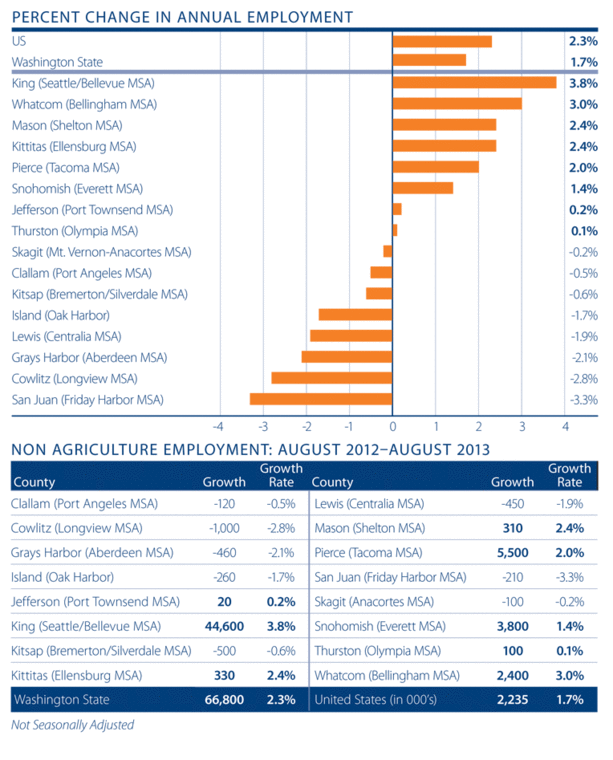
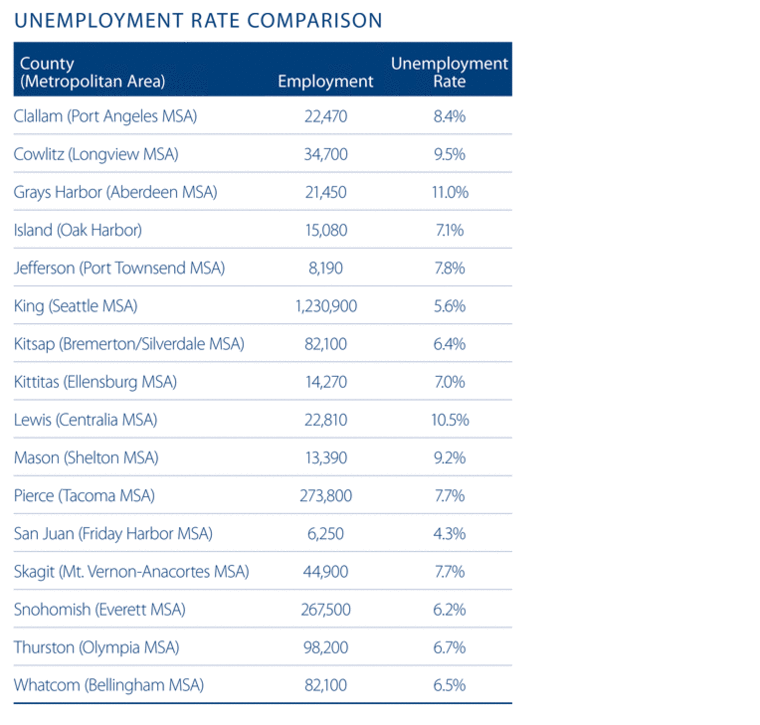
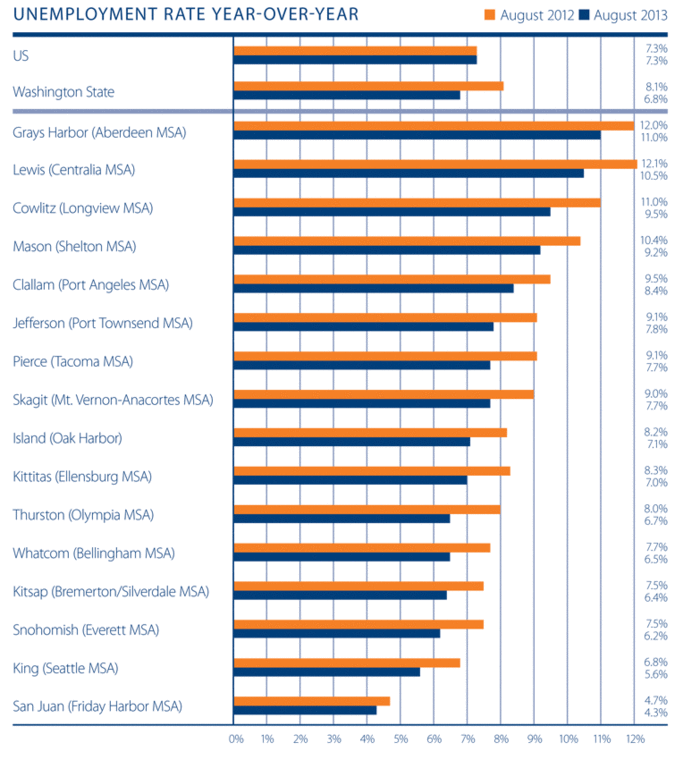 Year over year, the greatest drop in unemployment was seen in Lewis County where the rate dropped by 1.6 percent. This was followed by Cowlitz County where unemployment dropped by 1.5 percent, and Tacoma which dropped by 1.4 percent. The smallest improvement was seen in San Juan County where the rate improved by a modest 0.4 percent.
Year over year, the greatest drop in unemployment was seen in Lewis County where the rate dropped by 1.6 percent. This was followed by Cowlitz County where unemployment dropped by 1.5 percent, and Tacoma which dropped by 1.4 percent. The smallest improvement was seen in San Juan County where the rate improved by a modest 0.4 percent.
In general, the employment picture remains positive and, with total employment growth of 2.5 percent, we remain well above the U.S. rate of 1.7 percent. That said, I still want to see a more broad-based improvement in jobs. Many counties in the state are not improving at the rate that I would like to see. As such, I can only maintain the “B+” grade that I gave last quarter.
Regional Real Estate
It was a funny summer. Interest rates started to climb in June, and this certainly had an effect on the housing market with sales increasing nicely. What was also pleasing to see was a corresponding growth in listing activity.
As compared to September of 2012, listings in the region are up by 7.5 percent, and are now 12.4 percent higher than seen at the end of the second quarter of 2013.
The greatest growth in listings was seen in Snohomish County, which saw a remarkable 36 percent increase in units for sale when compared to a year ago. Every other county measured increases in the single digits, with just three counties reporting fewer homes for sale than a year ago. These were Skagit (-3%), and Cowlitz and Jefferson which each saw available inventories less than one percent lower than a year ago.
Most counties added to the stock of homes for sale, but some notable exceptions were in Island (-5%) and Jefferson (-4%) Counties.
I would temper this with the fact that listings in the region are still 43 percent lower than seen in September of 2008—just as the market was correcting.
When we look at sales activity, the region reported 48,203 home sales in the first three quarters of 2013—a 19.2 percent improvement over the same period in 2012. And when compared to the previous quarter, sales were up by a very reasonable 4.6 percent.
In the third quarter, sales essentially rose across the board with the greatest increase coming in San Juan County, where the market reported 48 percent more homes in the quarter than in Q2. (The total increase, however, was from 44 to 65 sales). This was followed by Grays Harbor (+44%), Jefferson (+37%), and Mason (+30%) Counties. Very slight contraction was seen in Snohomish and Skagit Counties, but sales were less than one percent lower than seen in the previous quarter.
Listings and sales are both on the rise and it will be interesting to see how the year finishes. During third quarter we saw interest rates rise and then pull back. Did this “pull” some sales forward that would otherwise have happened later in the year? Only time will tell.
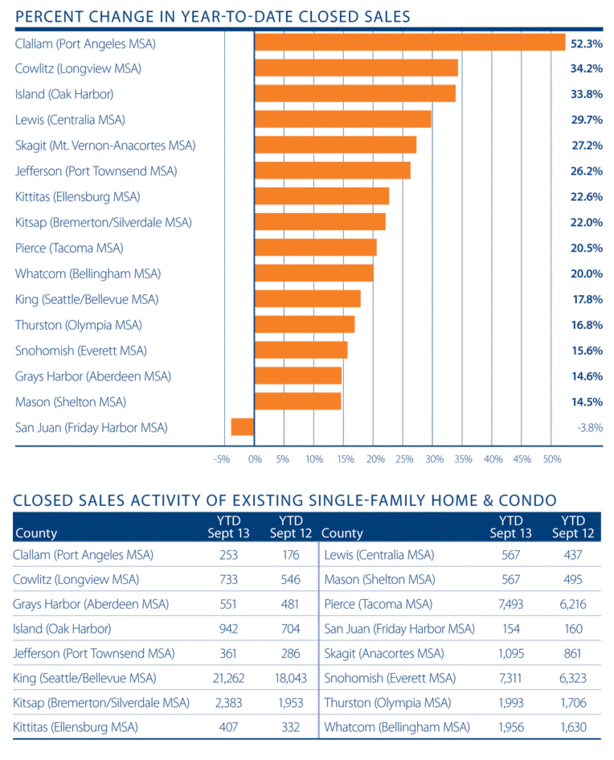
As shown in the chart below, nine counties saw the average sales prices at levels above that seen a year ago, with seven exhibiting prices below that seen in September of 2012. In aggregate, the average price of homes sold in the counties analyzed was nine percent higher at the end of the third quarter of 2013 than seen a year before.
Of the counties that saw appreciation, the most pronounced gains were seen in Jefferson County where prices rose by 21.5 percent. Significant gains were also seen in Whatcom (+15.5%), Kitsap (+14.1%), King (+11.7%), Cowlitz (+11.2%), and Snohomish (+10.3%) Counties. Declines were seen in the notoriously volatile San Juan County where home prices were 42 percent lower than a year ago. Price drops were also seen in Grays Harbor (-9.2%), Lewis (-8%), Island (-4.6%), Clallam (-4.1%), Skagit (-3%), and Mason (-1%) Counties.
When we look at the market versus the previous quarter, ten counties saw prices rise with six contracting. On the positive side, sales in the quarter grew the fastest in Clallam County where prices were 11.1 percent higher than seen at the end of Q2. Substantial increases were also seen in Whatcom (+8.9%), Kitsap (+5.9%), and San Juan (+5%) Counties. The most pronounced decline was seen in Lewis County where prices fell by 9.7 percent. Losses were also seen in Kittitas (-7.2%), Island (-7%), Skagit (-3.8%), Pierce (-3.3%), and Mason (-2.5%) Counties.
When compared to the housing market from two years ago, all but four counties saw home price growth, and we are now—five years later—starting to see some price growth versus September of 2008 when housing prices were at their peak.
The market has entered what I will refer to as a period of calm. The double-digit price growth that we have experienced over the past year or so is set to taper—which is not a bad thing. It is pleasing to see an increase in homes for sale in many markets throughout Washington. The market is demonstrating stability, and buyers are increasingly comfortable with the view that home buying is not an inherent risk.
I am upping the grade from a “C+” to a “B-”. Prices are calming and, although interest rates are sure to rise in 2014, the increase will not be parabolic. Rather, I believe that rising rates, along with higher inventory levels, will encourage those that are still on the fence, to get off.
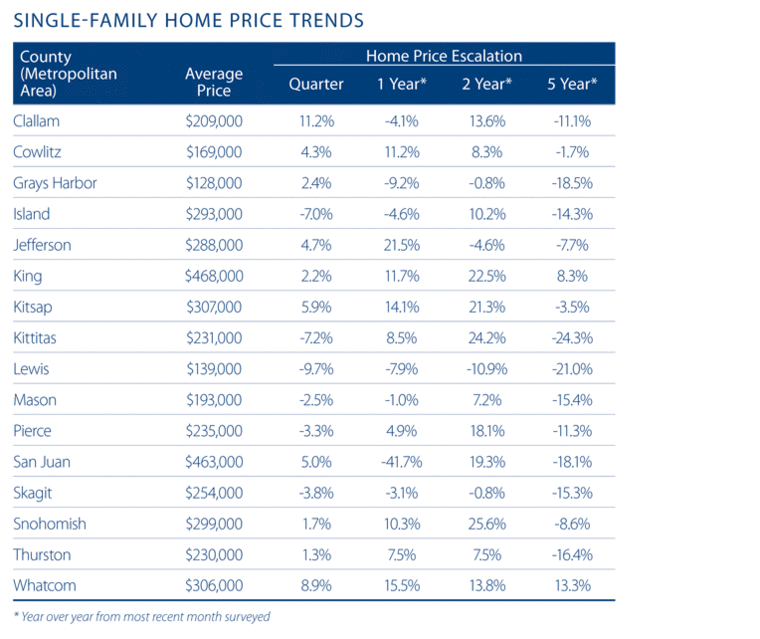
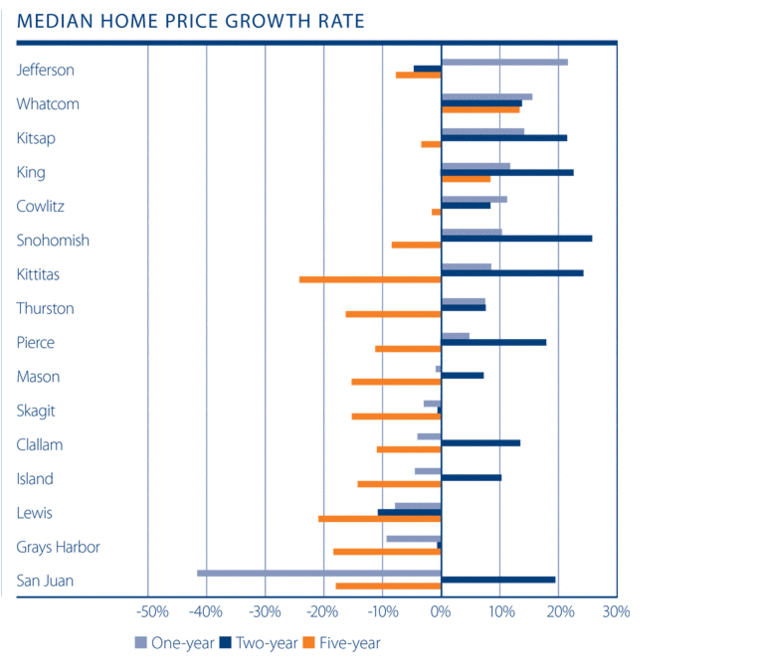
Conclusions
The economy and the housing market both continue to improve, but there are headwinds that need to be addressed.
The health of the housing market relies heavily on the greater economy. When the region, and the country as a whole, grows economically, jobs are created, wealth increases, and this has a direct effect on homeownership.
Recent events in the “other” Washington continue to be a concern. For now, the effects of the sequester, debt ceiling, and Affordable Health Care for America Act remain unknown. In as much as the government went back to work after a brief respite, and agreed to temporarily increase the debt ceiling, a more permanent solution was not enacted. This causes uncertainty in the private sector, which is very important since private companies are the ones who have essentially created all the jobs that have been seen over the past five years.
Why do I mention this? Until we get resolution to the issues that face the nation, we will not grow at our potential. This affects all of us, because it can lead us to adjust our spending patterns —which can include our home buying decisions—as we tend to fear what we do not know.
I do believe that our government will come up with long-term solutions to these problems; however, until they do, many will still keep tight hold of their spending “reins”. That said, the current economic environment is certainly better than it has been for several years. As long as we believe that our elected officials will address the bigger issues that face the nation, we will continue to exhibit economic growth, but not at the rate which I would like to see.
About Matthew Gardner
 Mr. Gardner is a land use economist and principal with Gardner Economics and is considered by many to be one of the foremost real estate analysts in the Pacific Northwest.
Mr. Gardner is a land use economist and principal with Gardner Economics and is considered by many to be one of the foremost real estate analysts in the Pacific Northwest.
In addition to managing his consulting practice, Mr. Gardner chairs the Board of Trustees at the Washington Center for Real Estate Research at the University of Washington; sits on the Urban Land Institutes Technical Assistance Panel; is an Advisory Board Member for the Runstad Center for Real Estate Studies at the University of Washington; and is the Editor of the Washington State University’s Central Puget Sound Real Estate Research Report.
He is also the retained economist for the Master Builders Association of King & Snohomish Counties. He has twenty-five years of professional experience in the U.K. and U.S.
He has appeared on CNN, NBC and NPR news services to discuss real estate issues, and is regularly cited in the Wall Street Journal and all local media.
 Facebook
Facebook
 X
X
 Pinterest
Pinterest
 Copy Link
Copy Link
